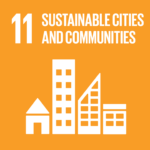In Pune’s Lavale village, Avasara Academy offers a climate-smart blueprint for low-cost, locally rooted sustainability
Tucked into the hillside of Lavale village near Pune, India, a school for young women is quietly rewriting the rules of climate-resilient design. The Avasara Academy, designed by Mumbai-based Case Design in partnership with Transsolar KlimaEngineering, is not just a residential school—it is a living, breathing model of how net-zero architecture can be achieved with modest resources, local materials, and a bold vision.
Here, in a landscape that balances the rural charm of farms with the edge of Pune’s expanding “Knowledge City,” the academy stands as both a sanctuary for learning and a prototype for the built environment in a warming world.
RELEVANT SUSTAINABLE GOALS



Designing for Climate, Not Against It
In a region marked by hot and humid weather, Avasara Academy achieves something remarkable: comfortable indoor temperatures without air conditioning.
How? Through passive design features woven into every corner of the campus. A network of earth ducts pulls in outside air, passively cooling it before it reaches classrooms and dormitories. Inside the main structures, solar chimneysintegrated into the building’s core help drive ventilation upward and out, creating continuous airflow.
Meanwhile, thick concrete floors and local stone walls provide thermal mass, moderating indoor temperatures throughout the day. The result is a learning environment that stays cool—without burning through electricity.

Local Materials, Global Lessons
Beyond the technical ingenuity, Avasara Academy is a case study in the power of locally sourced solutions. Instead of expensive imported cladding or prefabricated facades, the school uses bamboo mats for shading and pastel-painted concrete ceilings for lightness and vibrancy. Raw materials are celebrated rather than hidden, with unfinished stone, exposed concrete, and colored mosaics giving the structures a tactile, approachable beauty.
Each building was constructed with the help of local artisans, engineers, and residents—an act of participatory architecture that rooted the project in its community from the start.
The 4.3-acre campus is composed of six similarly configured buildings, each housing classrooms on the lower levels and dormitories above. These are not rigid, institutional spaces; they are open, breezy, and human-scaled, arranged around informal pathways, gardens, terraces, and shared courtyards.
Rather than box students into climate-controlled silos, the layout invites interaction with the environment. Covered walkways and brise soleil elements cast shifting shadows across corridors. Shared spaces breathe, buffer, and blend—fostering an immersive connection to place.
Powered by the Sun, Grounded in Purpose
While passive systems do the heavy lifting, solar panels on the rooftops meet the school’s electricity needs for lighting and ceiling fans, while solar thermal collectors provide hot water. These simple additions close the loop on energy demand, allowing the school to operate as a net-zero energy campus.
At its core, Avasara means “opportunity”—and this academy offers more than academic promise. It stands as a beacon for sustainable education infrastructure, especially in the Global South, where budget constraints often limit ambitious environmental design.
The success of Avasara Academy offers a critical lesson: Net-zero does not have to mean high-tech or high-cost. With strategic design, a deep understanding of local climate, and a commitment to material honesty, transformative architecture is possible—no matter the budget.
As the global conversation around climate action continues, schools like Avasara challenge the notion that cutting-edge sustainability must come with premium price tags or futuristic facades. Sometimes, the answers are rooted in the soil beneath our feet, the air around us, and the sun overhead.
And sometimes, the classroom is the building itself.
You may also be interested in :
Samsonite’s Scholar Panel Transforms Schools With Sustainable Innovation



